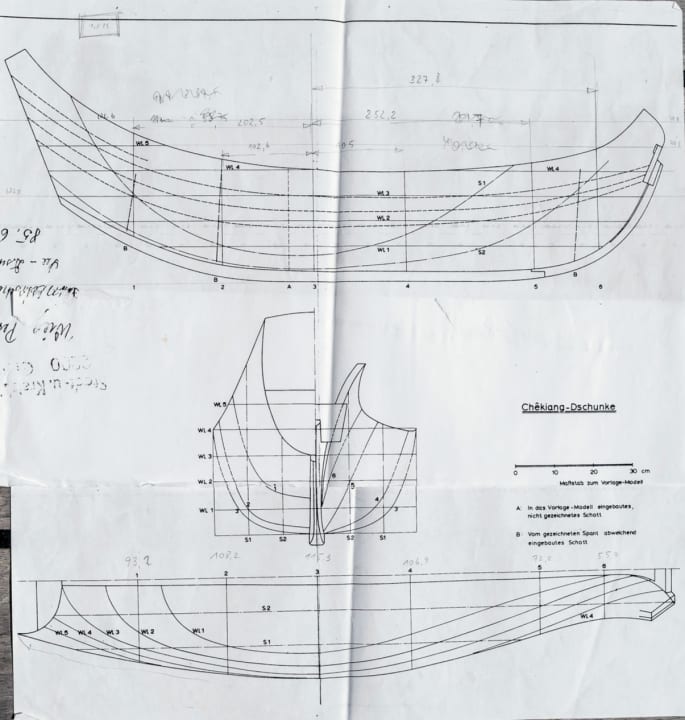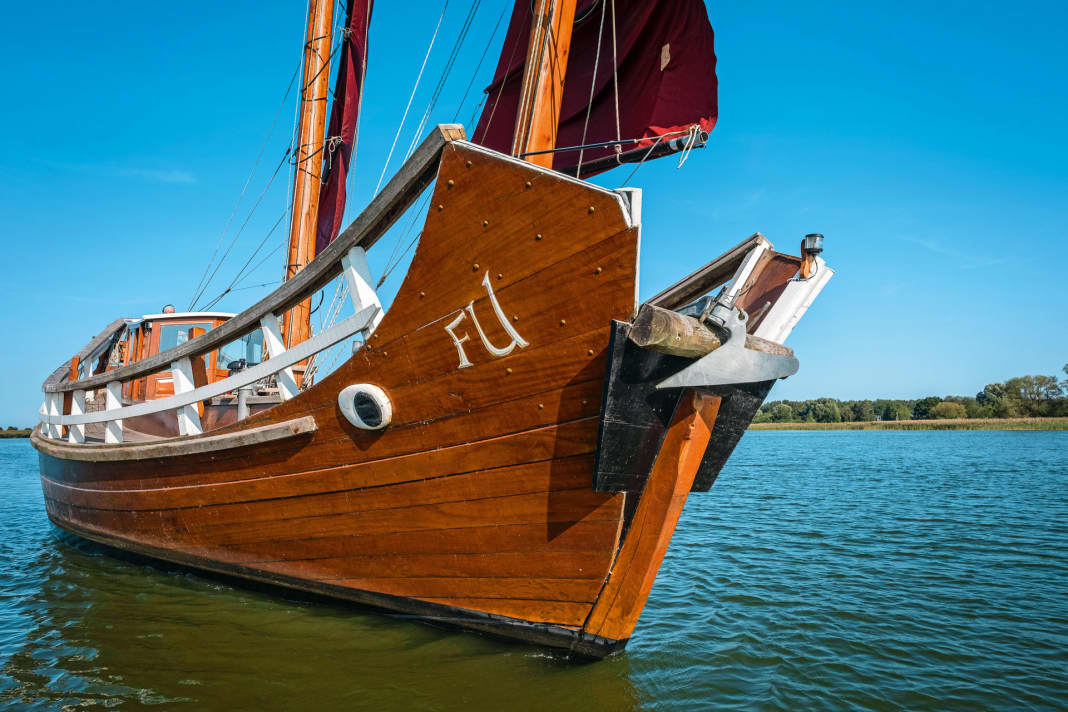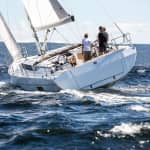By Christian Irrgang
The title of the book is just as unusual as the boat it leads to: "The Blue-Red Methuselah", published in 1888, describes the adventurous journey of a young student to China. The fifth chapter contains the following passage: "The large merchant junks are hulking ships of considerable size, whose front and rear decks are considerably higher than the centre board, which gives them a strange appearance. They protrude from the water with hippopotamus-like awkwardness.
Her stern is very broad, like that of an old Dutch ship of the line, colourfully painted and sometimes gilded, and the deck is covered with a huge thatched roof, which makes the vessel appear even more cumbersome.
Other interesting sailing ships:
The masts, which are extremely thick, consist of a single piece and have no stays, carry a pulley at the top, through which a heavy, strong rope runs, with the help of which the weighty mat sail is hoisted."
The author of this story was a young man from Saxony. However, he never saw the country he wrote about, like many others who served as the backdrop for his successful adventure novels. His name was Karl May.
This junk is a stunner
About a hundred years later, China fever broke out on parts of the Baltic coast. Unlike current epidemics, which for better or worse have to be associated with the Middle Kingdom, this epidemic was not fatal, not even harmful to health, and its long-term effects are only occasionally visible today. And when they come into view, everyone looks. For example, in the old harbour of Peenemünde. There is a sailing ship moored at the pier in a corner, which immediately catches the eye of every visitor eating a sandwich in one of the fish stalls opposite.
It is the "Fu" junk, 6.80 metres long and 4.80 metres wide. A high hull with an even higher stern, made of dark wood, which displaces no less than 35 tonnes. Two unstayed masts with strangely cut sails made of red cloth. If the basic parameters of this exotic boat are special, its genesis is even more so.
Building your own dream ship
A married couple wanted to have a ship built. Like Karl May, they came from Saxony. They envisioned a ship that they could sail as a couple and that would offer space for longer journeys. As it happened, their daughter and son-in-law were boat builders. Greta and Daniel Weiß, as they were known, worked on the move in the harbours on Mecklenburg's coast at the time, but they were looking far beyond the horizon. They wanted to build their parents' boat, and in the meantime they had heard about this Chinese thing, boats that are retrofitted with an exotic-looking rig and are therefore totally easy to steer.
The story of the "Jester" made the rounds, a Nordic folk boat with a junk rig, with which the English single-handed sailor "Blondie" Hasler had won second place in the first transatlantic regatta for small ships from a standing start. At some point, the cutter "Condor" appeared in the Baltic Sea, which had been conventionally launched in Beidenfleth in 1939 as a fishing cutter, but was then fitted with a junk rig by its new owner in 1990. That was the time when China fever was spreading. A sailmaker in Greifswald was soon infected and built a Loch Fyne skiff with a junk rig, and the future owner couple also caught the bug. A conventional hull, but with this exotic rig - that was the plan.
Planning finesse for mast and rigging
The advantages of the rig were convincing: a mast that stands without stays, sails that can be operated without sheet winches, infinitely variable reefing that is possible simply by furling the halyard. And additional sails are not required.
However, before the first plank could be sawn, the young boat builders happened to come across a book that had already been published by VEB Hinstorff-Verlag in Rostock in 1984. The title: "Chinesische See-Dschunken" by Peter Wieg - an incredibly detailed standard work with many illustrations and photos. On page 68 there was an exact description of the model of a Chêkiang junk, built in China and now on display in the Rostock Maritime Museum. The drawings of the model on a scale of 1:10 were printed in the appendix. During a visit to the museum, the model was inspected from all sides and photographed, and the decision was made: it should be a sailing ship like this, or even better, exactly like this one.
From model to reality
It takes a certain amount of fearlessness to extrapolate the data from a model to one-to-one in order to build a real ship afterwards; normally it works the other way round. Therefore, to be on the safe side, a working model was made first to test the buoyancy and the ratio of the ballast. The hull was made of fruit crate wood and sealed with cling film. When the thing actually floated upright, we got started. A courageous procedure.
The two boat builders were able to rent an old hangar at the disused Peenemünde military airfield. Alfonso Steinbrüggen, who was able to contribute valuable experience after converting his "Condor" into a junk, was now also on board as a consultant. They learnt from the district forester that a large oak tree had fallen in the nature reserve. Could they do anything with it? That's exactly what they were looking for! The trunk of this oak became what the foundation of a house is: the keel beam on which everything else could now be built. The wood for the frame also came from local forests. Robinia was the material of choice: extremely hard, tannic acid-free, so that iron bolts are not attacked. And what made this tree particularly suitable: its branches had the natural curvature for installation as frames.
Extensive work on the junk
The right ones simply had to be used. So we searched and tried for every single frame until we found the right timber - we got every piece ourselves from the forest on the Peenemünde hook. However, external timber was used for the planks, deck and bulkheads. Afzelia was used, 40 millimetres thick and, just like robinia, iron-neutral. The trunks of the two masts, on the other hand, had grown in the soil of Usedom: Thuja, arborvitae, were ideally suited due to their long-fibre wood and elasticity.
The design envisaged a strong hull with three separate compartments. A collision bulkhead was inserted behind the chain locker, watertight and ultra-strong, as the bulkheads had to be able to absorb large forces afterwards.
The masts, inserted through the deck, were to be firmly bolted to these bulkheads. The Afzelia boards were therefore double-thick, two times 40 millimetres. Because the foremast was to be inclined forwards by a few degrees, the forward bulkhead was set at an angle. The main bulkhead in front of the saloon would hold the main mast, plumb of course. Because it was not certain how the round hull would behave on downwind courses, a centreboard was fitted, but this soon proved to be unnecessary and was removed again.
Old parts, new use
The year is 2002 and a lot of floating scrap has accumulated in Peenemünde harbour since reunification. Lots of decommissioned warships, remnants of the navy of the National People's Army and some of the things that the Russians left behind when they withdrew at the end of the 1980s are now bobbing around. Everything that still works in some way is being dismantled; and a veritable technology flea market has sprung up on the airport site next door.
A huge diesel engine finds its way from here into the engine room of the junk "Fu" via a few detours. The JAS-204 with 130 hp, a four-cylinder two-stroke engine, once powered a Russian push boat used to lay pontoon bridges. It is cooled by a single-circuit keel cooling system and is therefore winter-proof. The biggest curiosity, however, is the pump toilet from a Russian submarine, which now shares the engine room with the engine. The aluminium steering wheel in the wheelhouse, originally from a GDR minesweeper, is a bonus.
Never before have Greta and Daniel Weiß built a sailing ship of this size themselves. The young enthusiasts work on the junk for three years. Then everything is ready for the launch. The "Fu" finally enters the water.
Junk as a cruising yacht with everything you need
As you approach the boat, you notice the positive deck projection, which is taken up by the roof of the wheelhouse. The model in the museum has no deck superstructure, but the "Fu" was intended to be a cruising yacht. In China, the Chêkiang junks are used as cargo sailing boats, which are loaded up to the top. To give the replica enough righting moment, lead bars were bolted to the keel beam on the "Fu". 100 pieces each weighing 100 kilograms, all specially cast.
Otherwise, everything is there to make the ship suitable for longer journeys. What is the hold in the original has become the saloon here. The galley, an L-shaped bench seat and two berths are located there. If required, heating is provided by wood or coal in a cast-iron stove. The multifunctional room for engines and toilet is accessible from the wheelhouse, as is the aft cabin with the wide double berth. Here, as in the saloon, all the frames are uncovered and every single robinia branch shows off its strength.
To start the diesel, Daniel Weiß presses a button with Cyrillic lettering, also an original part from the marine flea market. The engine runs surprisingly smoothly while Weiß steers the junk out into the Peene River. When we reach the fairway, he turns the bow into the wind and leaves the wheelhouse. Now comes another special gag. A post is mounted on the cabin roof, the purpose of which now becomes clear. An engine-driven forestry winch is attached to it and makes a hell of a noise when it is started. But the end sometimes justifies the means, and when Weiß places the main halyard on the winch drum and sets the sail, which weighs a hefty 150 kilos, without any physical effort, he can't help but grin.
The junk catches the eye
The foresail is also pulled into the mast in this way, creating a total sail area of 120 square metres. The noisemaker is silenced, as is the diesel, and then the ship starts to move. The wind is really light today, but the "Fu" is still making good time; yachts that overtake us are motoring. The crews don't even have a free hand to sail because they are taking photos from all angles.
But this is understandable, because a Baltic sailor really doesn't see this kind of sight very often. Unlike in Karl May's description, the ship does not make a ponderous impression at all, on the contrary. The most striking feature is certainly the silhouette of the sails. At first glance, the comparison with a quilted bedspread is obvious. The fabric between the continuous slats, which have been replaced here by aluminium tubes, curves like an inflated pillow. The sheet is attached to the aft end of the battens, runs through several blocks and is laid on the pushpit - without a winch. The same applies to the jib sheet, whose foot block is located at the bottom of the main mast. To prevent the sails from sliding forwards on the mast, each batten is held by a slider called a rack. The operation of this sail guide is very simple.
The junk is (almost) completely modelled on the original
Seen from behind, the hull of the junk is reminiscent of a cog - a flat-bottomed stern, but with striking Far Eastern-inspired decorations. There is also the sturdy, externally mounted rudder stock, which houses the curved tiller above deck. This is also made from a grown robinia trunk. On the Chinese models, this rudder stock can be moved vertically so that the rudder blade can be lowered for better trim. This is not possible on the "Fu" because a steel sleeve for the steering hydraulics of the inboard steering position prevents this.
Karl May once again has the floor for the description of the bow section: "To the right and left of the stem you can see one eye each, often four to five feet in diameter and painted in the brightest possible colours. From these two eyes, which show a peculiar staring expression, the junks have received the common name 'Lung-yen', which means dragon eyes. They are said to give the ship that menacing look which is supposed to drive away evil spirits and other unearthly monsters which at certain times descend to earth and especially into the water."
In contrast, the junk "Fu" sails the Baltic Sea completely undisturbed by evil spirits and monsters.
This article first appeared in YACHT 7/2021
Technical data junk "Fu"

- Designer: Greta and Daniel Weiß
- Torso length:16,80 m
- Width: 4,80 m
- Depth:1,70 m
- Weight: 35,0 t
- Ballast/proportion:10,0 t/28 %
- Mainsail: 71,0 m²
- Foresail: 41,0 m²
- Motor: (JAS 204) 130 HP
- Water/diesel: 800 l/1,200 l







